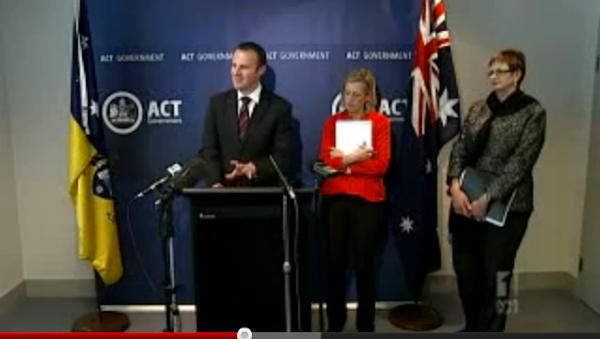
The Auditor-General has announced their report on Emergency Department Performance Information in the wake of the health statistics scandal.
Here are the conclusions:
Hospital records at the Canberra Hospital have been deliberately manipulated to improve overall performance information and reporting of the Canberra Hospital’s Emergency Department. The very poor controls over the relevant information system means that it is not possible to use information in the system to identify with certainty the person or persons who have made the changes to the hospital records. Under affirmation, anexecutive at the Canberra Hospital has admitted to making improper changes to hospital records. While this is the case, Audit considers that it is probable that improper changes to records have been made by other persons.
There is evidence to indicate that hospital records relating to Emergency Department performance were manipulated between 2009 and early 2012. It is likely that up to 11,700 records relating to Emergency Department presentations were manipulated during this period. The records that were manipulated mean that publicly reported information relating to the timeliness of access to the Emergency Department and overall length of stay in the Emergency Department have been inaccurately reported over this period.
Data manipulation
The executive has admitted to manipulating hospital records initially in 2010 and on a much larger scale throughout 2011 into early 2012. The executive’s admission of manipulating records does not account for all of the changes that were made to hospital records, where timeliness information was improved. The executive did not admit to making changes to records in 2009. Furthermore, changes to hospital records made throughout 2010 and early 2012 are not all accounted for by the executive’s admission.
The executive’s rationale for manipulating records was that they felt under significant pressure to improve the publicly reported performance information of the Emergency Department. In this respect, Audit notes that there is a significant and ongoing focus on the timeliness performance of the two Canberra hospitals more broadly, and their emergency departments more specifically. Audit also notes that the recent National Partnership Agreement between the states and territories and the Commonwealth has placed an additional focus on hospital waiting times, targeting $3.4 billion in investment over the eight years to 2016?17 on hospital improvement. Of this Commonwealth funding, a comparatively small proportion ($200 million nationally and $3.2 million for the ACT) is directly dependent on improvements to Emergency Department timeliness performance. There is a considerable lack of attention on qualitative indicators, which may provide a more appropriate and rounded assessment of Emergency Department performance.
Managerial pressure was placed on the executive to improve the performance of the Emergency Department. This managerial pressure reflects the significant and ongoing focus on the timeliness performance of the Canberra Hospital and the requirements of the National Partnership Agreement. An organisational change management agenda was also underway at the Canberra Hospital since the restructure of the Health Directorate in early 2011. The organisational change process underway at the Canberra Hospital sought to achieve improved performance and accountability for performance.
Organisational change can be challenging and confronting for staff. In relation to the organisational change that was underway at the Canberra Hospital throughout 2011, one stakeholder commented to Audit:
The hospital is very resistant to outsiders coming in, very resistant. In a way, it’s a very protected community and it has developed from a small regional hospital, you know, the Woden Valley Hospital, to the major tertiary referral centre for the region. And one of the challenges…is whether the change has happened as it’s needed to for staff to move into that much more professional high-pressure dynamic organisation.
Although managerial pressure was placed on the executive to improve the performance of the Emergency Department, this was not manifested in direct or indirect instruction or guidance to deliberately manipulate hospital records. Furthermore, there was no direct or indirect instruction by any other person, including the Minister for Health.
Very poor systems and practices
The very poor systems and practices in place in the Canberra Hospital and the Health Directorate for preparing and publicly reporting performance information created the opportunity for persons to manipulate the hospital records. The Emergency Department’s management information system, which is used to prepare the performance information, has very poor system access and user controls. There is a lack of governance and administrative accountability for this system, which means that there is no identifiable system owner with responsibility for ensuring the integrity of the system and the appropriateness of its access and user controls.
The very poor system access and user controls over the Canberra Hospital’s Emergency Department management information system has wider implications beyond the inaccurate reporting of timeliness performance. There are risks to the privacy and confidentiality of patient information. The very poor systems and practices also mean that there is a risk that the Health Directorate does not meet the requirements of Principle 4.1 of the Health Records (Privacy and Access) Act 1997 relating to the safekeeping of personal health information.
Audit notes that the same management information system, albeit a newer version, is used at the Calvary Public Hospital. There are more effective system access and user controls over the newer system at the Calvary Public Hospital. Nevertheless, some features of the newer system and its implementation at the Calvary Public Hospital may also give rise to risks relating to the privacy and confidentiality of patient information and the potential manipulation of hospital records to improve timeliness performance reporting. There is also a risk, albeit to a lesser extent, that Calvary Public Hospital does not meet the requirements of Principle 4.1 of the Health Records (Privacy and Access) Act 1997 relating to the safekeeping of personal health information.
There was also a lack of monitoring, review and assurance of the integrity and accuracy of the Health Directorate’s publicly reported Emergency Department performance information. Various data validation processes are in place within the Health Directorate, but these processes have not been designed to provide assurance over the integrity and accuracy of publicly reported Emergency Department performance information.
Audit notes that the current monitoring, review and assurance processes over the publicly reported Emergency Department performance information are not consistent with the apparent importance of the performance information, as demonstrated by the significant Health Directorate management and stakeholder interest.
Commonwealth funding
A comparatively small amount of Commonwealth funding under the recent National Partnership Agreement ($3.2 million over the four years to December 2015) is contingent upon the ACT meeting relevant timeliness targets. $0.8 million is contingent upon the ACT’s timeliness performance in 2012. This funding may be at risk, as it appears that the ACT is not meeting its timeliness performance targets. However, it should be noted that this reward funding may be rolled over and provided in future years up to 2015.
A response from Andrew Barr is expected after 2 (Chief Minister Gallagher having stood aside from this matter due to a friend of her family’s involvement) and no doubt Jeremy Hanson will not be far behind.
UPDATE 03/07/12 15:41: The Greens are first out of the blocks, calling it fraud but wanting a more wholistic approach and pointing out that KPI obsession inevitably leads to bad management:
“The comprehensive report by the Auditor General into the manipulation of ED data has shown the extent of this manipulation by an ACT Health employee. While the individual is not blameless, the report shows the need to examine the reasons behind their actions,” ACT Greens Health spokesperson, Amanda Bresnan, said.
“This highlights many of our concerns about the impact of the focus purely on ED waiting times on patient safety and risk of fraudulent activity that can create.
“There is a continual focus on ED waiting times and other similar measures by both Labor and the Liberals and also in the media, which leaves out any debate about the quality of care or the outcomes people are receiving.
“The Auditor General’s report released today raises considerable concern that the measure, when used by itself, places patient safety at risk. The report also states that there is a considerable lack of attention on qualitative indicators.
UPDATE 03/07/12 15:45: Andrew Barr has announced that everything is fine:
The Health Directorate has already put in place measures to ensure the integrity of data at the Canberra Hospital, and is already moving to implement longer-term measures to ensure the robustness of data now and into the future.
It is important to remember that the issue relates to the altering of data after the care provided in the Emergency Department, and is not about the level of care provided while in the ED.
The Canberra Hospital’s staff are the best in the country, and the Emergency Department has the highest patient satisfaction rates in the country.
UPDATE 03/07/12 17:18: The Liberals’ Zed Seselja and Jeremy Hanson have taken the time to write a lengthy and damning response which concludes thusly:
“This is Katy Gallagher?s legacy as Minister. Not only has the Auditor General discovered a decade of decline in our emergency department but under Katy Gallagher?s failed leadership, a culture of fear, intimidation, and bullying has led to deception on a massive scale.
“Through the revelations that the health system has gone from the best in Australia to the worst, of revelations of a ten year war in Obstetrics that Katy Gallagher knew was happening, with doctors quitting over bullying, to now find out we have been lied to for years utterly destroys Katy Gallagher?s credibility and calls into question every statement about the health system Katy Gallagher makes.
“The first thing we must do as an Assembly is recall Katy Gallagher to the Estimates Committee and go through what this means for the budget – over $800,000 is already at risk and none of the other data is reliable. An ACT version of a Royal Commission also needs to be called for a full investigation as to what happened and why.
“If we do not get to the bottom of this falsification, these appalling results, Canberrans will be going to the election with nothing but a pack of lies and falsified figures from Katy Gallagher and ACT Labor,” Mr Hanson concluded.
UPDATE 03/07/12 19:28: The ABC’s coverage is worth a look. How convenient that senior health executives have decided it’s too hard to figure out which of their number were involved.
UPDATE 04/07/12 09:52: For posterity’s sake here’s a recording of the Ross Solly interviews this morning with the party leaders.
I particularly enjoyed the Chief Minister saying that it’s too hard to switch users on computer systems in a hurry (thus requiring generic logons). The wrist bands used by bar staff to identify themselves to their tills would seem to be a pretty easy place to start.



















